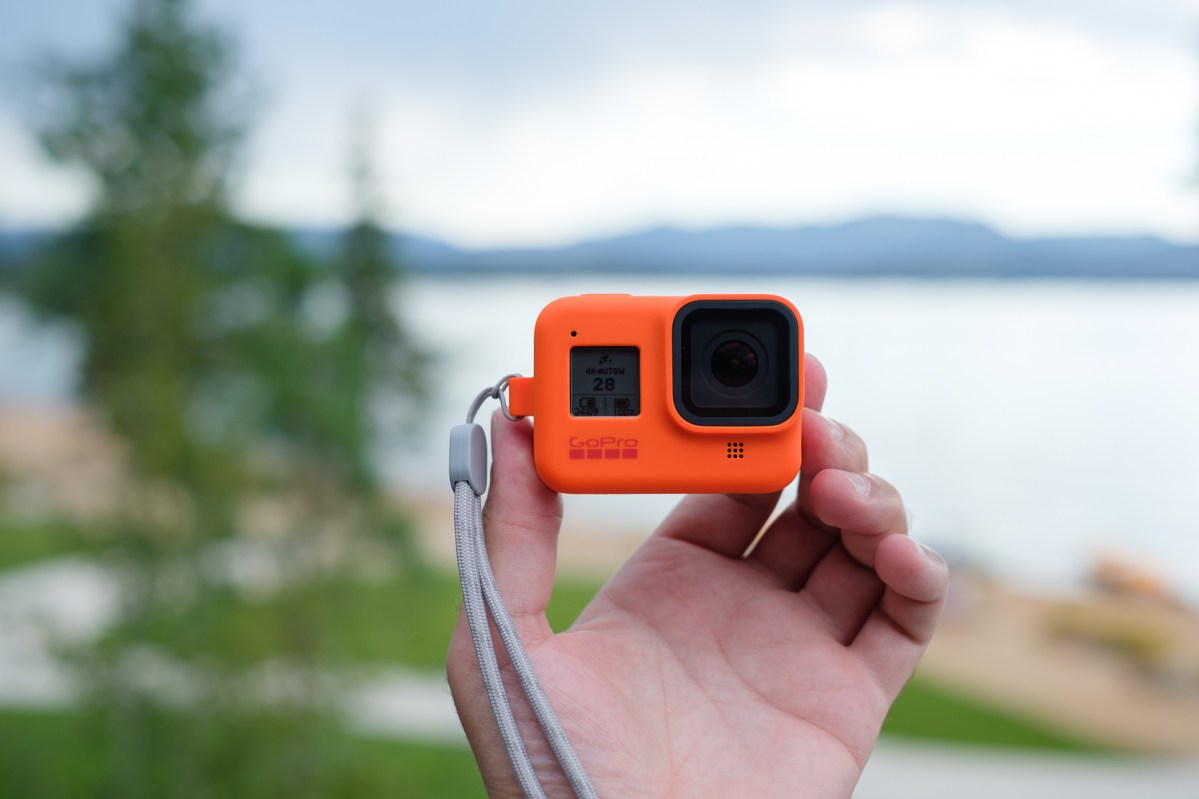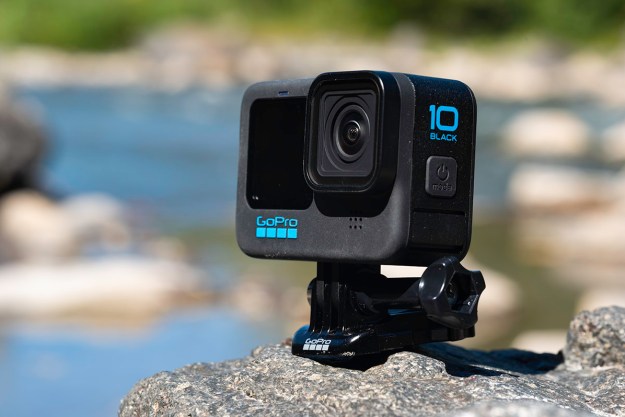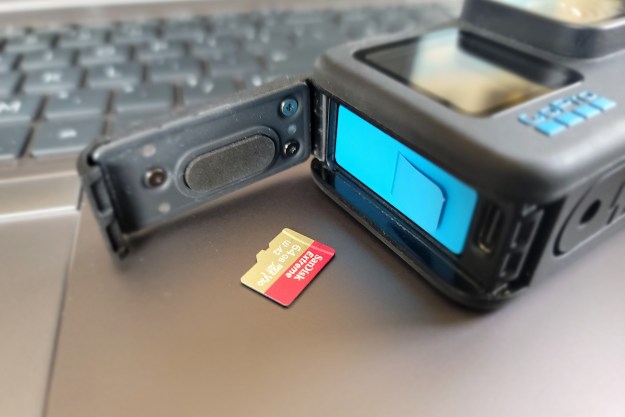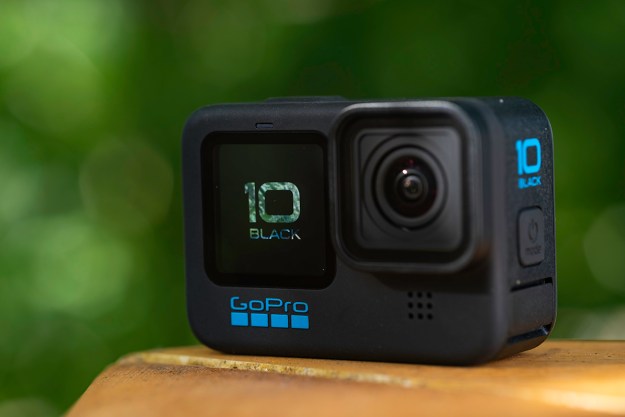DJI entered the action camera market earlier this year with the Osmo Action, an innovate attempt to take on GoPro’s Hero7 Black. It was an impressive first-generation product, but it wasn’t long before GoPro came back with the Hero8 Black — which quickly found its way to the top of our best action cameras list in addition to earning a 9/10 score in our review. While the Hero8 Black is an exceptional action camera, the Osmo Action still stands out in a few ways — not the least of which is its cheaper price — and may have some features that make it the better choice for you. Here’s how the two stack up.
Design
This is where the DJI Osmo Action really tries to differentiate itself with a front LCD monitor. This helps frame up those walk-and-talk vlogging shots or preview your shot when mounting the camera in such a way that the rear screen is blocked. Additionally, the main LCD on the back of the camera is a wide, 16:9 screen measuring 2.25 inches at a resolution of 640 x 360. That’s larger and sharper than GoPro’s 2-inch, 480 x 320 screen.

The Hero8’s main trick is that it contains a built-in mount so you can ditch the mounting frame that’s needed with the Osmo Action (as well as older GoPro cameras). Despite this extra built-in hardware, the Hero8 Black is the lighter of the cameras by a narrow margin, at 4.13 ounces compared to 4.37, and noticeably smaller compared to an Osmo Action in a case. Both cameras are waterproof to about 33 feet.

While the Hero8 doesn’t have a front-facing monitor, it is compatible with a new system of accessories called Mods. The GoPro Display Mod ($80) adds a 2-inch, flip-up selfie screen, but you’ll also need the Media Mod ($80) before you can connect it. These accessories, along with the $50 Light Mod, transform the Hero8 Black into a powerful production tool, but it comes at a cost.
Stabilization
Good electronic image stabilization (EIS) can make shaky amateur video look smooth and professional, and both the DJI Osmo Action and GoPro Hero8 Black have top-notch EIS systems. DJI’s RockSteady stabilization is an impressive feat for a first-generation camera, competing neck-and-neck with GoPro’s HyperSmooth stabilization in the Hero7 Black. But when GoPro released the Hero8, it also introduced HyperSmooth 2.0, which made another leap in stabilization performance. The Hero8 Black has the best electronic stabilization we’ve seen, but both cameras do well.
Video
Both the Osmo Action and Hero8 Black use 12-megapixel sensors and shoot 4K video at up to 60 frames per second, or up to 240 fps at 1080p resolution for 8X slow motion. Both also record at up to 100 megabits per second which ensures your footage isn’t marred by too much compression.
The two cameras aren’t identical, however, and each employ some software tricks to achieve unique looks. The Osmo Action has a high dynamic range (HDR) video mode that holds more detail in the highlights and shadows of a high-contrast scene. This is great for sunny outdoor activities like a day at the beach. GoPro doesn’t have HDR in video (it does in still photos and time-lapses), but it offers a unique ultra-wide perspective in its patented SuperView mode. SuperView uses the full 4:3 area of the imaging sensor, but intelligently stretches it into 16:9 widescreen without distorting objects near the center of the frame. The result is a wider vertical field of view in a video that still fits the standard frame size and looks great.
Time-lapse and hyperlapse
While both cameras can shoot time-lapse videos, only the Hero8 offers a hyperlapse mode (which GoPro calls TimeWarp). A hyperlapse is a time-lapse video in which the camera is also moving. New to the Hero8, TimeWarp can now set the hyperlapse speed based on the detected movement of the camera, so you always get a good result (or you can set the speed manually if you prefer). You can also slow down the hyperlapse to real time at any point with the press of a button, which is great for drawing attention to people, objects, or other points of interest as you approach them.
Still photography
Action cameras can’t replace the best DSLRs or mirrorless cameras for still photography, but they continue to get better at it. The Osmo Action and Hero8 Black both shoot 12MP stills in JPEG or RAW. We’re big fans of GoPro’s SuperPhoto mode that automatically applies HDR processing, local tone mapping, or multi-frame noise reduction depending on the scene. It’s a fool-proof way to get a great photo in-camera without having to worry about enhancing an image later.
The Osmo Action has one particular advantage when it comes to extreme low-light shooting: An extra-long exposure time. While the Hero8 can reach a respectable shutter speed of 30 seconds, the Osmo can hit 120 seconds. That’s great for shooting something like the night sky and capturing star trails. It’s not a feature everyone will take advantage of, and requires a tripod or other stable mounting surface, but it’s a neat feature to see in an action camera.
Interface and control
One thing that GoPro continues to do well is its user interface, and the Hero8 Black is no exception. It’s a refinement of the same touch interface that’s been around since the Hero5 Black, and it’s still the best. With the Osmo Action, DJI built what feels like a very GoPro-inspired touch interface, and it works very well. It also benefits from the Osmo Action’s wider screen, which gives your fingers a bit more room, but we still lean slightly toward GoPro here. Regardless, both cameras are easy to use and simple to set up.
Mobile app
In 2019, an action camera isn’t just a camera. Built for fast-paced athletes and adventurers who don’t have hours to spend at a computer, the Osmo Action and Hero8 Black connect wirelessly to a smart device for on-the-go editing. Both companies offer decently powerful apps that let you put together a polished video using nothing other than your phone.
GoPro has a big head start on DJI here, and its app is definitely the better of the two. From changing camera settings to importing and editing footage, it is clearer, easier, and faster. We also like GoPro’s QuikStory feature, which edits together clips automatically and can even match the cuts to music for a short, shareable video that’s ready for social media. DJI’s My Story mode is similar, but wasn’t as intuitive in our experience.
Value
Overall, GoPro offers the more mature ecosystem when you look at the camera, accessories, and mobile app experience together. The Hero8 Black has some clear advantages over the DJI Osmo Action, as well as some fun features like TimeWarp that we really enjoyed. But the Osmo is no slouch; we love it’s large rear screen, screw-on filters, and convenient front-facing monitor. It’s also $70 cheaper than the Hero8.
If money is no object, the Hero8 Black is the best action camera you can buy right now. But if you’re looking for high quality on a budget, the Osmo Action is an excellent choice that even offers a few things the Hero8 doesn’t, like the front-facing monitor.
Editors' Recommendations
- The 15 best GoPro accessories in 2024
- Why I fell in love with action cameras in 2022, and what I think comes next
- GoPro Hero 11 Black leak suggests a moderate upgrade
- GoPro takes to the skies with the Hero10 Black Bones
- GoPro keeps recording as parrot steals it from tourists and flies off




